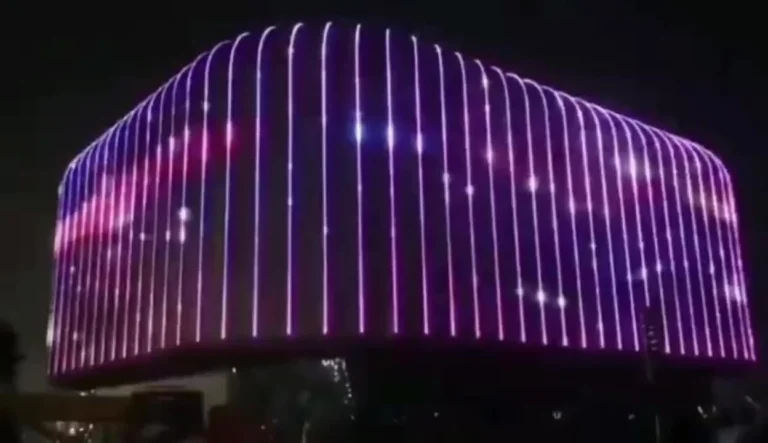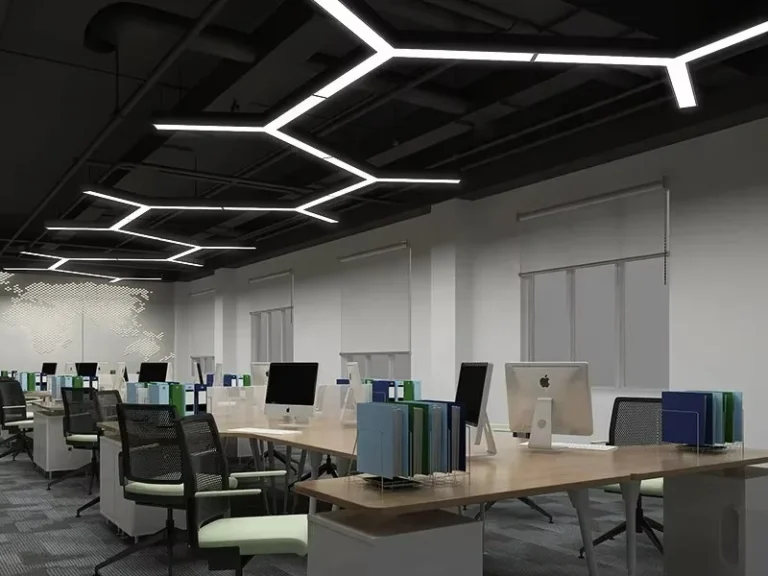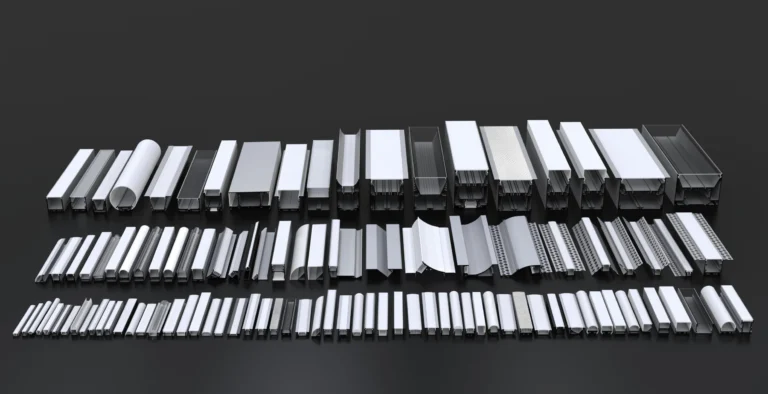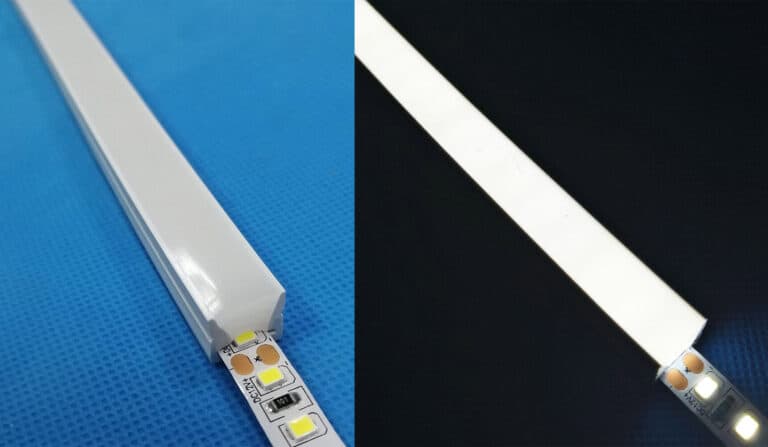Ticari aydınlatma ve ev tasarımında, LED doğrusal ışıklar, şık tasarımları ve tek tip ışık dağılımı için yaygın olarak popülerdir. Ancak, birleşik parlama derecesinin (UGR) ihmal edilmesi, görsel yorgunluğa ve hatta güvenlik tehlikelerine yol açabilir. Uygun aydınlatmayı bilimsel olarak seçerek “ışık kaynağını görmeden ışığı görme” konusunda rahat bir deneyim elde edebiliriz.
Uluslararası standartlara göre, farklı senaryoların UGR için açık gereksinimleri vardır. Ofisler ve sınıflar genellikle UGR≤19 gerektirirken, bazı üst düzey sergi salonları ve hastaneler UGR için daha yüksek gereksinimlere sahiptir ve UGR≤16 gerektirir. Bu nedenle, UGR, LED doğrusal ışık satın alırken göz ardı edilemeyecek önemli bir faktör haline geldi.
LED doğrusal ışıklar 19'dan daha az bir UGR elde edebilir mi?
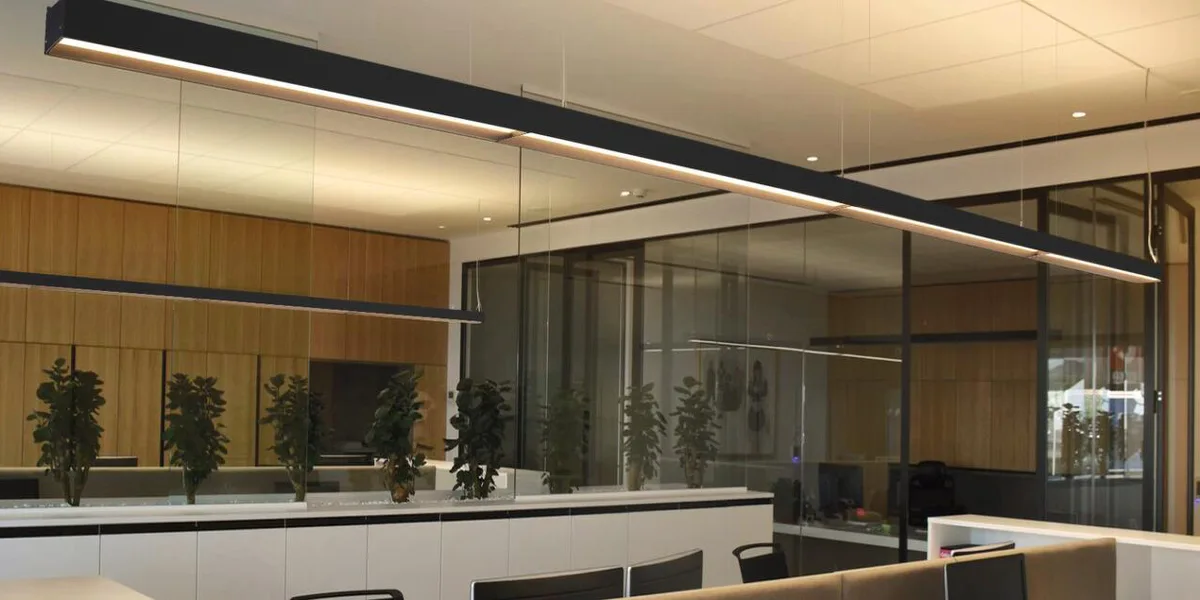
evet, LED doğrusal ışıklar 19'dan az bir UGR elde edebilir. Birleşik Parlama Derecelendirmesi (UGR), aydınlatmanın parlama etkisini ölçmek için önemli bir parametredir. Ofisler gibi sağlıklı aydınlatma ortamları, görsel konfor sağlamak için 19'dan az bir UGR gerektirir. Örneğin, düşük parlama için özel olarak tasarlanmış LED lineer ışıklar, bina aydınlatma standartlarına uygun mikro yapılı parlama önleyici optik malzemeler aracılığıyla 19'un altındaki UGR değerini stabilize edebilir.
Ancak, doğrudan bir aydınlatma kaynağı olarak, doğrusal ışıklar, yanlış tasarlanırsa, parlama riski oluşturabilir. Aşağıdaki gerçek ölçüm verilerinde gösterildiği gibi, UGR değerleri CIE'nin önerilen üst limitini aşarak 22'ye ulaşabilir ve sık göz bebeği kasılması ve baş ağrısı gibi rahatsızlıklara yol açar. Bu nedenle, ürünleri seçerken, UGR gereksinimlerini açıkça karşılayanlara öncelik verilmesi tavsiye edilir.
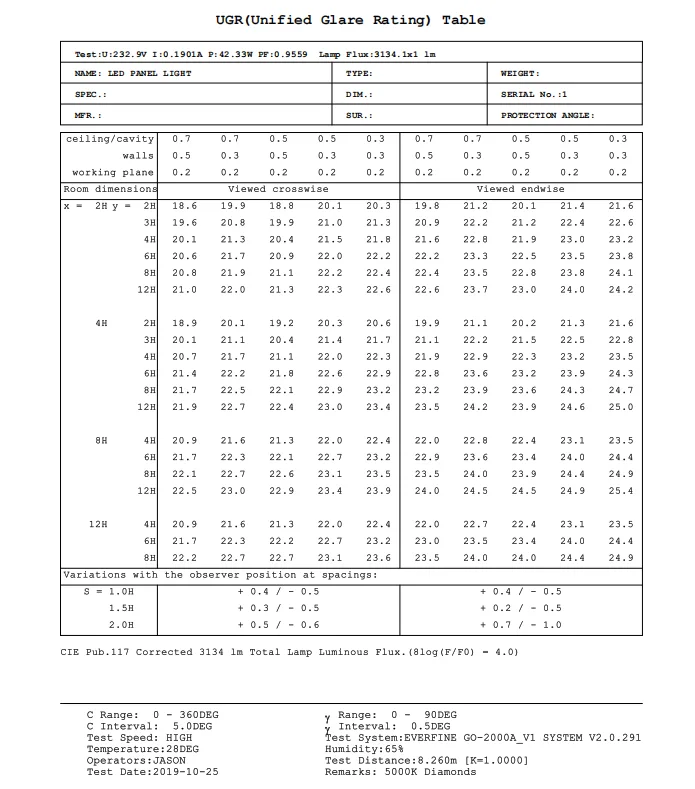
Doğrusal ışıkların parlama derecesi (UGR) neden 19'dan az olmalıdır?
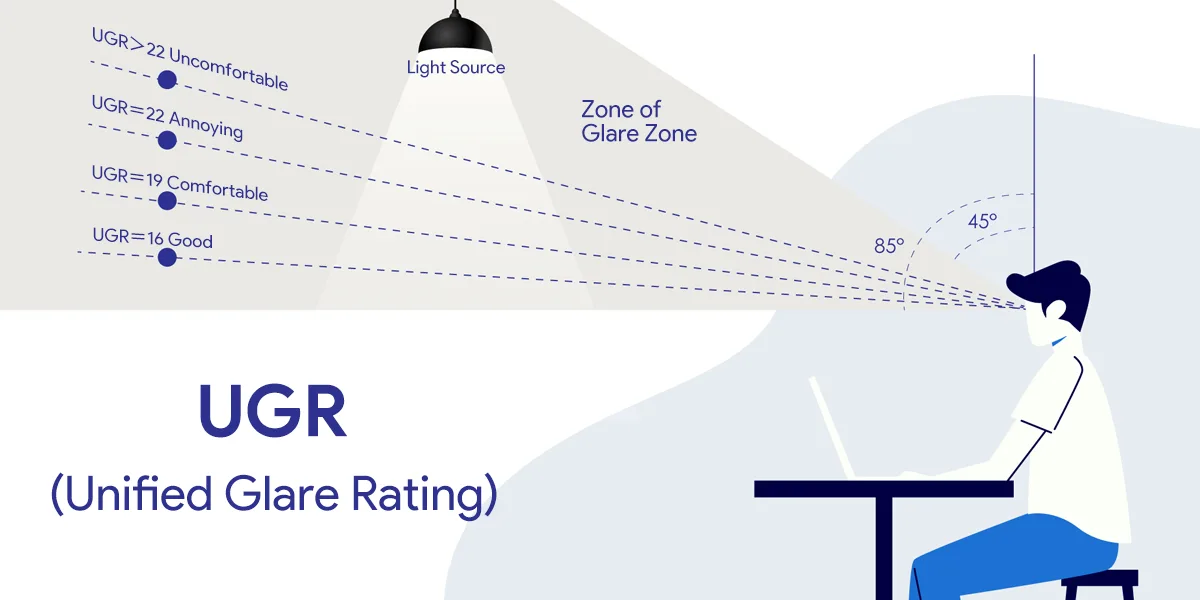
UGR (üniform parlama derecesi), iç mekan doğrusal aydınlatmanın parlama seviyesini değerlendirmek için uluslararası kabul görmüş bir standarttır. UGR değeri ne kadar düşükse, parlama o kadar zayıf ve görsel konfor o kadar yüksek olur. UGR değeri, ışık kaynağı parlaklığı, konum ve ortam ışığı seviyeleri dahil olmak üzere birçok faktörden etkilenir.
UGR 19'u aştığında, öğrenciler sıklıkla ayarlanır ve bu da görsel yorgunluğa yol açar. Uzun süreli maruz kalma retina hasarına, görme bozukluğuna ve katarakt riskinin artmasına neden olabilir. Yalnızca 60%'nin üzerinde ergenin miyopiden muzdarip olduğu Çin'de, parlama kirliliği birincil katkıda bulunan faktörlerden biri olarak tanımlanmıştır.
Mevcut standartlar, sağlıklı aydınlatma ortamlarında UGR değerlerinin 19'un altında olmasını gerektirmektedir. UGR'nin 19'dan az olması şartı öncelikle aşağıdaki nedenlere dayanmaktadır:
- Görsel konfor sağlamak: 19'luk bir UGR değeri, orta ve anlamlı parlama arasındaki eşiği işaretler. UGR ≥ 19 olduğunda, göze batan ışık hissi önemli ölçüde artar ve potansiyel olarak görsel yorgunluğa veya rahatsızlığa neden olur. Ancak, UGR < 19 olduğunda, parlama kabul edilebilir bir aralıkta kalır ve bu da onu uzun süreli odaklanmanın gerekli olduğu ofisler ve sınıflar gibi ortamlara uygun hale getirir.
- İş yeri gereksinimlerine uyum sağlama: Ofis alanlarında ve hassas görsel görevler gerektiren diğer ortamlarda, UGR ≤ 19 standart aydınlatmayı ve konforu dengeler ve iş verimliliğine parlamanın engellenmesini önler. Örneğin, GB50034-2013 standardı, genel ofis alanları için UGR üst sınırının 19 olduğunu ve doğal ışık ortamlarının konforlu deneyimini simüle ettiğini açıkça belirtir.
- Özelleştirme Uygulama Senaryoları: UGR değerlerinin dereceli tasarımı, farklı konumların tolerans seviyelerini dikkate alır - UGR < 19, yüksek talepli ortamlar (ofisler gibi) için uygundur, bu da fark edilir bir parlamaya neden olan UGR ≥ 19, yalnızca görsel konfor gereksinimlerinin daha düşük olduğu endüstriyel tesisler veya mağazalar için önerilir.
UGR değeri nasıl derecelendirilir?
UGR değerinin (tek tip parlama derecesi) konfor derecelendirmesi, uluslararası standartlarda açıkça tanımlanmıştır. Özel konfor eşikleri ve uygulanabilir senaryolar aşağıdaki gibidir:
Ugr < 13 olduğunda, ışık yumuşaktır ve insan gözü parlamayı zar zor algılayabilir. Bu, sanat galerileri ve üst düzey konutlar gibi son derece yüksek görsel konfor gereksinimlerine sahip alanlar için uygundur.
Ugr < 16 olduğunda, görsel görevleri etkilemeyen hafif parlama ile konfor aralığına girer. Bu, sınıflar, okuma odaları ve hassas çalışma gerektiren diğer ortamlar için önerilen standarttır. Örneğin, sınıflardaki göz koruyucu panel ışıkları, ergenlerin görüşünü korumak için UGR ≤ 16'yı kontrol etmelidir.
UGR Değeri ve İnsan Algısı Durumu Derecelendirmesi
| UGR menzili | insan algısı | Uygulanabilir senaryo örnekleri |
| ugr < 13 | Algılanabilir bir parlama yok | Hastaneler, üst düzey sergi salonları, özel kurumlar |
| 13 ≤ UGR ≤ 16 | hafif parlama | Hastaneler, Kıdemli Aktivite Merkezleri |
| 16 ≤ UGR < 19 | Orta derecede parlama, kabul edilebilir ancak yorgunluğa neden olabilir | Sıradan ofisler, toplantı odaları |
| 19 ≤ Ugr < 22 | Göze çarpan rahatsızlık eşiği | Endüstriyel tesisler, depolar |
| UGR ≥ 22 | Yoğun parlama, baş ağrısına neden olur | Uzun süreli insan doluluktan kaçının |
Konfor ve rahatsızlık arasındaki psikolojik eşik UGR = 19'dur, ancak sağlıklı görsel ortamlar (öğrenme alanları gibi) UGR ≤ 16'yı hedeflemelidir.
Uygulama senaryoları için zorunlu standartlar:
- eğitim tesisleri: Derslikler için zorunlu UGR ≤ 19, yüksek kaliteli aydınlatma çözümleri ≤ 16'ya kadar optimize edilmelidir;
- Ofis Ortamları: UGR > 19 sık sık gözle görülür şekilde kasılmaya neden olur ve görme yorgunluğuna neden olur; 19. sırada sıralama puanı ≤ 19;
- sanayi siteleri: UGR ≤ 22'ye izin verilir, ancak sağlık risklerini azaltmak için parlama önleyici aksesuarlar kullanılmalıdır.
Parlama Koruma Uygulaması Önerileri
| tedbir | Teknik ilkeler | UGR azaltma etkisi |
| Mikro-Prizma Difüzyon Paneli | Yüksek yoğunluklu ışık huzmelerini ayrıştırır | ≤16'ya düşürür |
| Dolaylı aydınlatma tasarımı | İnsan gözü çevresinde 30° girişim bölgesini önler | 30% ile azalır |
| Düşük parlaklıklı malzemeler | Çevresel yansıma parlamasını azaltır | 2-3 puan ile optimize eder |
Not: UGR ölçümleri, balık gözü lensli dağıtılmış bir fotometre gerektirir; hata ±10%'yi aşarsa kalibrasyon gerekir.
Avrupa ve Amerika Birleşik Devletleri'nde lineer aydınlatma için UGR gereksinimleri
Avrupa ve Amerika Birleşik Devletleri, LED doğrusal aydınlatma için UGR gereksinimleri için net derecelendirme standartlarına sahiptir. Özel düzenlemeler ve uygulama noktaları aşağıdaki gibidir.
Zorunlu UGR derecelendirme standartları
AB çekirdek standartları: Tüm iç mekan doğrusal aydınlatma, UGR ≤ 19'un minimum güvenlik eşiğini karşılamalıdır. Bu değerin aşılması CE sertifikası alamamanıza neden olur. Özel yerlerin daha katı gereksinimleri vardır: Eğitim/Ofis alanları: UGR, sınıflar ve açık plan ofisler gibi ≤16 olmalıdır; Sanat galerileri/tıbbi tesisler: UGR ≤13 olmalı ve petek parlama önleyici yapılar kullanılmalıdır.
Kuzey Amerika Özel Gereksinimleri: UL 1598 standartları, fotobiyolojik tehlikeleri kontrol etmek için açıkça LED aydınlatma armatürleri gerektirir (4400-780 nm dalga boyu bandı hariç); Energy Star sertifikası, ticari aydınlatma armatürlerinin UGR ≤ 22'ye sahip olmasını ve mavi ışık seviyelerini göstermesi gerekir (RG0 muafiyet seviyesi önceliklidir).
UGR Ölçüm Kabul Özellikleri
| Öğe | AB standartları | Kuzey Amerika Ek Gereksinimleri |
| Gözlem yüksekliği | 1.2m / ayakta 1.5m | CIE 117-1995 standardına uygundur |
| Ölçüm Ekipmanı | 143° görüş alanı görüntüleme parlaklık ölçer | UL fotometrik kalibrasyonu geçmeli |
| Arka plan parlaklığı düzeltme | Armatürlerden doğrudan ışık girişimini ortadan kaldırır | Ayna Yansıma Algılama Öğesi Ekler |
Avrupa ve Kuzey Amerika Arasında UGR Standartlarının Karşılaştırılması
| gösterge | Avrupa | Kuzey Amerika |
| zorlama gücü | UGR > 19 piyasa dolaşımı yasaklandı | Energy Star Sertifikası Gönüllü Uygulama |
| Teknik Odak | Çekirdek odak olarak parlama kontrolü (UGR) | Fotovoltaik güvenlik + enerji verimliliği çift kontrol |
| Yön yükseltme | 2025 yılına kadar UGR ≤ 16'yı uygulayın | Düğme pil aksesuarları için güvenlik standartlarını güçlendirin (UL4200A) |
| çekirdek eşikleri | UGR ≤ 19 Zorunlu Eşik (CE Sertifikası Temel Gereksinim) | Federal düzeyde zorunlu eşik yok; Energy Star ≤ 22'yi önerir |
| Özel senaryo gereksinimleri | Eğitim/Tıbbi Tesisler UGR ≤ 13 | Endüstriyel aydınlatmaya izin verilir UGR ≤ 25 (UL 1598 elektrik güvenliği standartlarını karşılamalıdır) |
gözle görülür Parameter Ctoplanma
- AB: Armatürden doğrudan ışıktan kaynaklanan girişimi ortadan kaldırmak için 143° görüş alanı görüntüleme parlaklık ölçerin zorunlu kullanımı;
- Kuzey Amerika: UL fotometrik kalibrasyon ekipmanını geçmeli ve ayna yansıması algılaması eklenmelidir.
gözlem referansı
- AB, göz seviyesi için 1,2 m/durum yüksekliği 1,5 m'lik bir oturma yüksekliği benimser;
- Kuzey Amerika, AB standartlarına uygundur ancak üreticilerin kendi test yüksekliklerini (kayıtlara tabi) tanımlamalarına izin verir.
Avrupa ülkeleri, 2025'ten itibaren UGR≤16 kapsama alanı (ticari alanlar dahil) ile aynalı tavanlar için zorunlu gereksinimleri uygulayacak.: Armatür yüzey parlaklığı ≤2000 cd/m²; Yansıma özelliğine sahip buzlu abajurlar <60%.
Kablosuz kontrollü aydınlatma armatürleri ayrıca aşağıdakilere uygun olmalıdır:: FCC Radyo Frekansı Sertifikası (47 CFR Bölüm 15) ve Düğme Hücresi Pil Aksesuarları UL 4200A3 ile uyumlu olmalıdır.
trend uyarısı: AB'nin 2025'teki yeni düzenlemeleri, UGR değerlendirme sistemine fotobiyolojik güvenliği (RG0) dahil edecek ve Kuzey Amerika aynı anda UL 153 Mavi Işık Kontrol Standartlarını yükseltecek.
LED doğrusal ışıkların UGR değeri nasıl ölçülür?
ugr değeri LED doğrusal ışıklar genellikle fotometrik veriler elde edebilen ve standart yazılım kullanarak hesaplamaları simüle edebilen bir gonyotometre kullanılarak ölçülür. Aşağıdakiler, belirli test prosedürleri ve kilit noktalardır:
Doğrusal aydınlatma armatürünü gonyotometrenin dönen montajına sabitleyin. Fikstür veya reflektörü döndürerek, ışık yoğunluğu dağılım verilerini 360°'lik bir boşlukta yakalayın ve ışık akısı ve ışık yoğunluğu dağılımı gibi parametreleri içeren IES formatlı bir fotometrik dosya oluşturun.
Uzun lineer ışıklar tipik olarak iki eksenel simetrik fikstürler kategorisine aittir (örneğin, uzun panel ışıkları), iki simetrik düzlem için ışık dağılım eğrilerinin test edilmesini gerektirir: boyuna düzlem (C0-C180) ve enine düzlem (C90-C270).
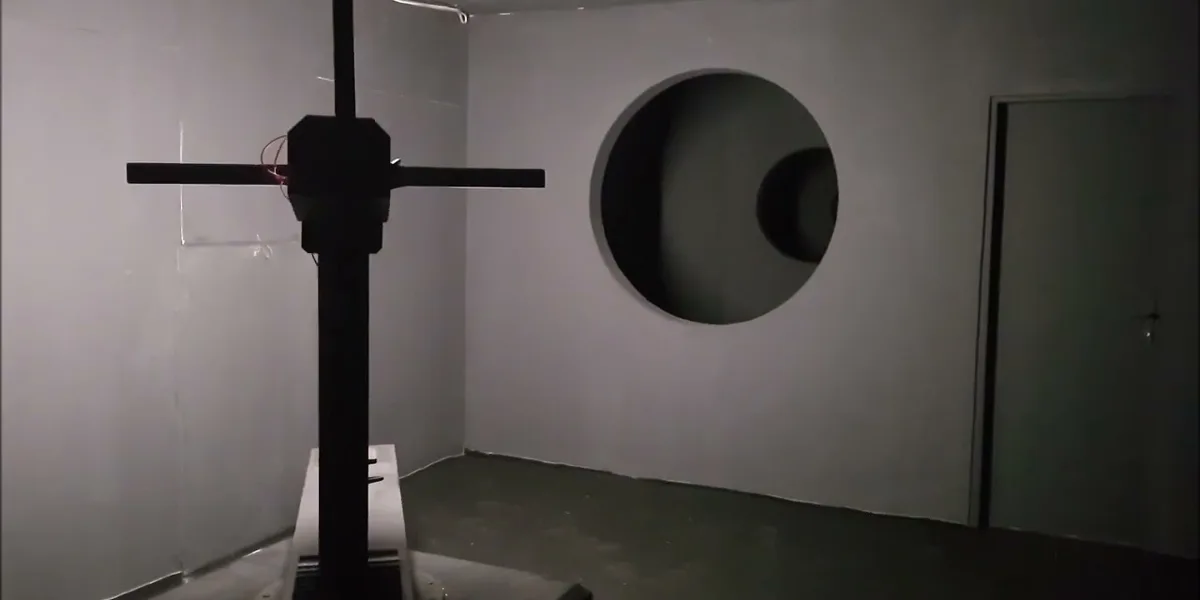
Veri doğrulama
IES dosyasının tam ışık dağıtım bilgisi (yarı tepe kenar açısı ve ışın yayılma açısı gibi) içerdiğinden ve UGR hesaplama koşullarını karşılamak için armatürün ışıklı katı açısının 0.0003 ila 0.1 SR aralığında olduğundan emin olun.
IES dosyasını simülasyon yazılımına aktarma
Doğrusal bir aydınlatma armatürü IES dosyasını Dialux gibi profesyonel yazılımlara yüklerken, dosyanın tamamen simetrik veya çift eksenli simetrik bir formatta olduğunu doğrulayın (asimetrik fikstürler UGR tabloları oluşturamaz). IES dosyası otomatik olarak uyum sağlamazsa, bir düzeltme aracı kullanarak simetriyi ayarlayın.
Standart simülasyon ortamını kurun
CIE 117-1995 standartlarına göre, sanal bir oda oluşturun ve anahtar parametreleri tanımlayın:
- Uzay Boyutları: uzunluğu ve genişliği x=2h, 4h, 8h, 12h'ye göre dinamik olarak ayarlayın (burada h, gözlemcinin gözlerinden armatür kurulum yüksekliğine kadar olan yüksekliktir);
- yansıma: tavan ve duvarlar için gerçek yansıma katsayılarını girin (varsayılan değerler: tavan 0,7, duvarlar 0,5);
- Gözlemci konumu: Armatürün merkez noktasından varsayılan bir mesafe ile yatay bir görüş hattını koruyun.
- UGR tablosunun oluşturulması ve düzeltilmesi: Yazılım, 1000 lm ışık akışında çıplak ışık kaynağı için teorik değerleri temsil eden “Referans UGR Aydınlatma Değerlendirme Tablosu” (düzeltilmemiş UGR tablosu) çıkarır.
- Gerçek UGR düzeltme formülü: gerçek ugr = tablo değeri + 10 × log(armatürün gerçek ışık akışı / 1000). Örneğin, armatürün ışık akışı 2000 lm olduğunda, tablo değerine 3 ekleyin (10 × log ≈ 3).
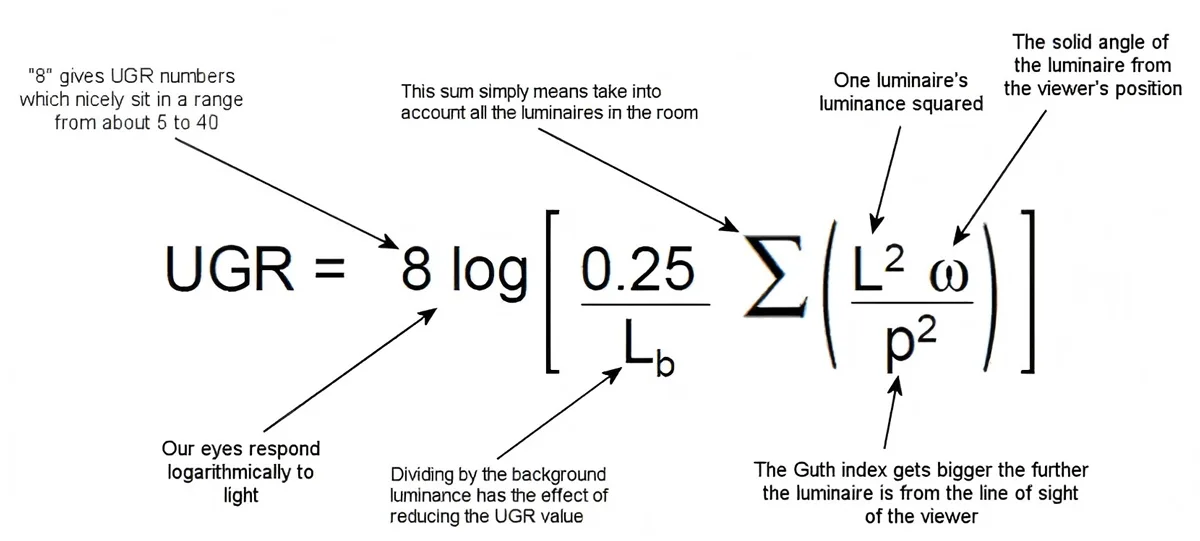
- Uygulama Sınırlamaları: UGR sadece iç ortamlara ve iki taraflı simetrik armatürlere uygulanabilir; Polarize tasarımlı lineer armatürler (simetrik olmayan dağılımlı duvar yıkama armatürleri gibi) bu yöntem kullanılarak doğrudan değerlendirilemez.
- Ölçülen UGR ve Simülasyon Sonuçları Arasındaki Farklar: Simülasyon sonuçları standart çevresel referans değerleridir; gerçek kurulumlar mekansal boyutlardan, yansıtıcı malzemelerden vb. etkilenir.
Doğrusal ışıkların UGR değeri nasıl etkili bir şekilde azaltılır?
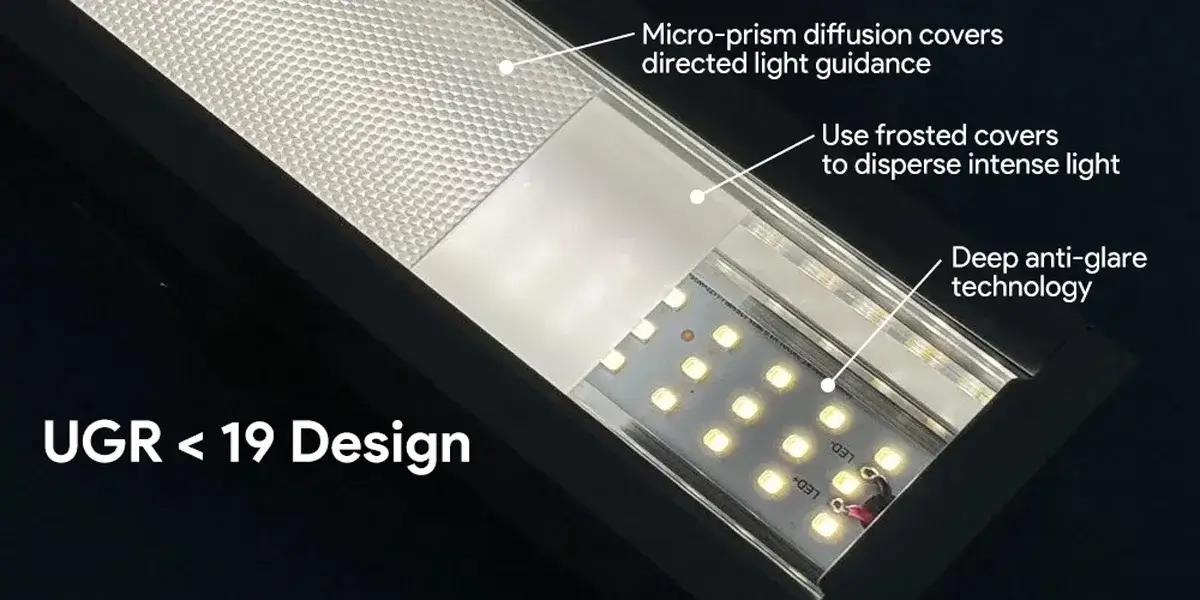
- Optik yapı optimizasyonu: Doğrudan ışığın gözlere ulaşmasını engellemek için ≥25 cm parlama açısı ile parlama açısı tasarımı ve derin parlama önleyici teknolojiyi benimseyin. Endüstriyel ayarlar için, ışıkların ≥3,5 m yüksekliğe monte edilmesi ve parlamayı azaltmak için reflektörlerle birleştirmeniz önerilir.
- yüzeye çıkarmak Tyeniden bakım Teknoloji: Kayış yansımaları zayıflatmak için bir bal peteği parlama önleyici ağ kullanın, UGR'de 30% azalması (özellikle yüksek yansıtmalı ortamlar için uygundur); alternatif olarak, yoğun ışığı dağıtmak için buzlu/mat abajurlar kullanın, eşit ışık difüzyonu sağlayın, <60% yüzey yansıması;
- küçükPrilâyet DIF kaynama Perkekler: Yönlendirilmiş ışık kılavuzu, UGR'yi 21'den 14'e düşürür.
- Kurulum ve L-ehlizade Ckontrol: Açıkta kalan lambaları önlemek için gömme kuruluma öncelik verin; lineer ışıklar tavanlara veya duvarlara (gömülü derinlik ≥2 cm) gömülmelidir; yüzeye monte edildiğinde, ışığı çalışma yüzeyine doğru yönlendirmek için polarize lensler kullanılmalıdır. Lambalar, göz seviyesinin 30°'sine yerleştirilmemelidir (yerden ≥1.8 m yükseklik daha güvenlidir); ikincil yansımaları bastırmak için aynalı tavanlar buzlu abajurlarla eşleştirilmelidir.
- Duvar malzemesi kontrolü: Beyaz duvarlar veya fayanslar gibi yüksek yansıtıcı malzemelerden kaçınarak mat boya (yansıma <60%) kullanın; doğrudan ışığı dağınık ışıka dönüştürmek için kavisli yansıtıcı ışık yuvaları takın (ölçülü UGR 21'den 13'e düşürüldü).
- Rg0-Level Blacivert LTamam. Ckontrol: fotobiyolojik stimülasyonu azaltmak için tam spektrumlu ışık kaynaklarını kullanın;
- ukalâ Demziren SSİSTEM: Yüksek parlaklıktaki alanlarda kontrastı dinamik olarak azaltın (FCC/CE sertifikalı olmalıdır).
- nota lar: Şeffaf LED ampuller açıkta kalan ışık kaynaklarıdır ve şiddetli parlamaya neden olabilir; lamba aralığının ≥ 1,5 katı kadar yüksek güçlü yoğun düzenlemelerden kaçının; yansıtılmış mobilya, masa ve ekran gibi yansıtıcı yüzeyler armatürün projeksiyon açısıyla dengelenmelidir.
- Etki Vayıklama: ≤19 (ofis) veya ≤13 (tıbbi/eğitimsel) sağlamak için 143° görüş alanı görüntüleme parlaklık ölçer kullanarak düzeltilmiş UGR değerini ölçün.
Ek olarak, UGR ≤19'u karşılamak için aydınlatma projeleri üçlü teknoloji kontrolü kullanmalıdır:
- gözle görülür DTASARIM: Yüzey parlaklığını azaltmak için mikro yapılı ışık difüzyon plakaları kullanın;
- strateji: İnsan gözü müdahale bölgesinden kaçının (30° yukarı görüş alanı içinde);
- Malzeme Sseçme: Yansıtıcı parlamayı azaltmak için düşük parlaklıkta malzemeler kullanın. Örneğin, sınıf aydınlatması UGR ≤ 19 (Ulusal Standart GB7793-2010) olması zorunludur, üst düzey armatürler (sokak lambaları gibi) daha da uGR ≤ 16'ya kadar optimize edilmiştir.
- Optimizasyon: Mikro prizma difüzyon panelleri takın: UGR 21'den 14'e düşürülebilir; Polarize lensleri kullanın: Endüstriyel ayarlar UGR ≤ 25'e izin verir, ancak yansıması ≤ 60% olan duvarlarla eşleştirilmelidir.
- Kurulum Tabuları: Çıplak lambaların insan gözünün 30° yatay görüş alanı içine yerleştirilmesini kesinlikle yasaklayın; yerden 1,8 metre yükseklik daha güvenlidir; aynalı tavan ayarlarında buzlu abajurlar kullanılmalıdır.
Signlitele LED Linear Işığın dört temel avantajı
Olağanüstü optik performans: UGR < 19 ile parlama azaltma tasarımına sahip olan ışık, ışık lekesi sınırının keskinliğini etkin bir şekilde kontrol eden ve müze sınıfı parlama bastırma standartlarına ulaşan yüksek hassasiyetli bir optik lens sistemi ile tamamlanan prizmatik bir difüzyon paneli aracılığıyla eşit olarak dağıtılır.
Endüstriyel sınıf yapısal tasarım: Havacılık sınıfı alüminyum alaşım profilleri ve nano kaplama teknolojisi ile üretilmiş olup, -30°C ila 60°C arasında aşırı ortamlara dayanabilen bir IP66 koruma derecesine sahiptir. Yenilikçi modüler montaj yapısı, kavisli veya düzensiz alanlarda kurulumu sağlayan 0° ila 90° arasında çok boyutlu ayarı destekler.
ukalâ Ekosistem BENhizipçilik: Dahili DALI/PWM çift protokollü sürücü, ana akım akıllı kontrol sistemleri ile uyumludur. Grafen ısı dağılımı teknolojisi, 50.000 saatin üzerinde bir kullanım ömrü ile birleştiğinde 93%'nin üzerinde enerji verimliliği dönüşümü sağlar ve geleneksel aydınlatma armatürlerine kıyasla 40% enerjiden tasarruf sağlar.
farklı Vşahane: Ürün CE ve RoHS tarafından onaylanmıştır ve 5 yıl garantilidir. Özelleştirilmiş servis sistemleri, ticari alanlar, sanat galerileri ve diğer senaryolar için özel renk sıcaklığı (2700K'dan 6500K'ya ayarlanabilir) ve renk oluşturma indeksi (RA ≥ 95) gereksinimlerini karşılayabilir.
Olağanüstü optik performansı, dayanıklı endüstriyel sınıf yapısı, akıllı kontrol uyumluluğu ve son derece özelleştirilmiş hizmetleri ile SignliteLed'in LED doğrusal ışıklar modern mimari aydınlatma ve üst düzey ticari alanlar için ideal bir seçim haline geldi. İster yeni bir inşaat projesi ister bir aydınlatma yükseltmesi gerçekleştiriyor olun, SignLiteled size daha verimli, daha akıllı ve daha tasarım odaklı aydınlatma çözümleri sağlayabilir.
